When sorting through things stored in a closet, you can find items that have not been useful for years. If you feel sorry to throw them away, you can transform an unnecessary thing into a necessary one. For example, a good solution would be making warm house slippers, and life-size patterns will help with this.
What to sew house slippers from
Any fabric can be used to make house slippers. The main thing is that it is warm.

For sewing soft home shoes, you can use the following materials:
| Product area | Materials |
| Warp |
|
| Sole |
|
| Insoles |
|
Another lining is often placed between the soles and insoles, for example:
- cardboard;
- foam rubber;
- synthetic.
To make a pattern, in addition to materials, you need to have the following tools and items on hand;
- thick paper or cardboard: the patterns will be made from these;
- writing instruments; pencils, pens, markers, crayons;
- Scissors: necessary for cutting paper and fabric;
- needles and thread: required for sewing;
- tailor's tape measure: it is necessary for the pattern, which is made on the basis of the results obtained during the measurement.
Construction of life-size patterns
House slippers (a life-size pattern makes it easy to sew the future product) can be ordinary flip-flops. They require a few materials, and the pattern will be extremely simple.
Homemade slippers can also have backs or an extended shaft. If you wear such products in winter, your feet will be warm and comfortable. However, the process of making such shoes requires diligence and time. It will also require more material than in the case of simple flip-flops.
The process of making slippers begins with a pattern. At this stage, it is important to take measurements correctly. Patterns must be built according to the size of the foot. To do this, you will need to know the length and width of the soles, the circumference, the distance to the instep.
In the work it is necessary to use a centimeter tape. The obtained results of the measurement are written down on a sheet of paper.
Pumps
The easiest way to make a pattern is for pump slippers.
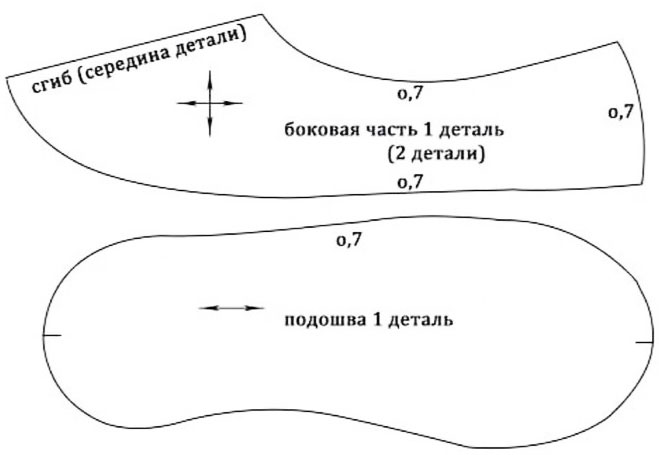
Place your foot on a thick sheet of paper and trace it with a pencil. Next, adjust the sole according to the measurements obtained.
Slippers-boots
Slipper-boots are similar to boots, but differ from them in that they are made of lighter materials.
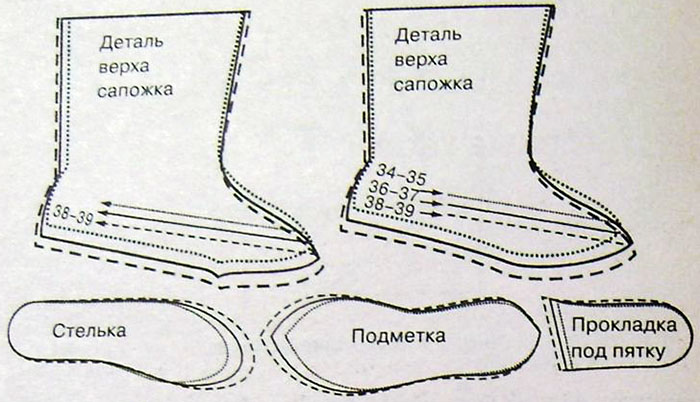
To make closed house slippers, you need to do the following:
- Place the foot sideways so that you get something that looks like a simple drawing of a boot. First, outline one leg separately, then the other. The number of parts may vary depending on the shape of the shoe. For example, the upper part can be represented by a single element that combines the side, nose and heel. It can also be represented by 3 elements - 2 side parts and 1 part that will be located above the foot.
- Make a pattern for the bootleg or the part of the slippers that will eventually become the fur cuff. To make this cuff, you need to measure your leg in the calf area using a tape measure. Then, make an allowance of a few millimeters. Thanks to this, the bootleg will become looser.
- Before creating the upper part of the shoe, measure the foot from the tip of the big toe to the end of the instep. The shaft will be sewn to this part later.
- When cutting out pattern elements, leave seam allowances (15-20 mm).
Closed-toe slippers without heels
House slippers can be sewn without heels with a closed toe. It is easy to create a life-size pattern for them. To do this, you need to trace the foot of the person for whom the shoes are being made on a piece of thick paper.
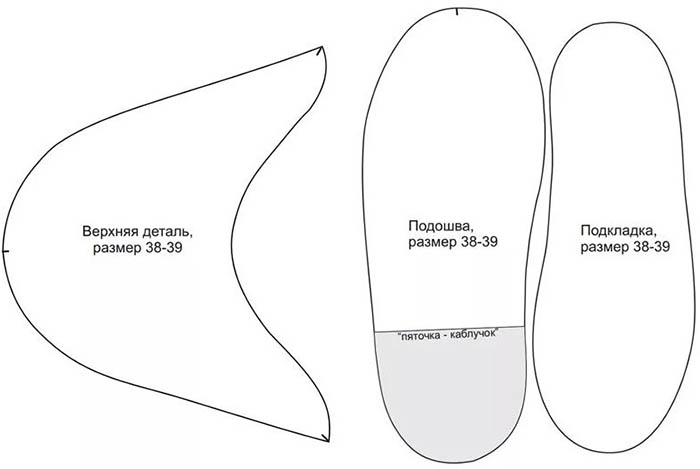
In this case you will need:
- 2 soles;
- 2 outer sides;
- 2 top parts.
Open toe slippers
Making open-toe slippers also begins with cutting out the sole and upper part.
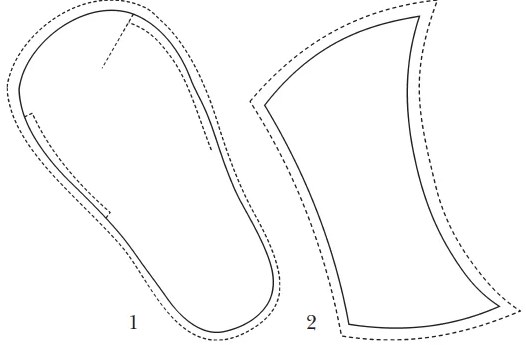
For each slipper you will need 6 pieces of:
- material for the sole;
- sole sealant;
- fabrics for soles;
- lining fabrics;
- fabrics for the outer side;
- synthetic padding for the top.
Instructions for sewing house slippers
House slippers (a life-size pattern makes it much easier to work with the product) are easy to make, following a detailed description of each stage.
Made of felt
The process of making soft felt slippers goes through the following stages:
- Prepare a template. You can put your foot on a sheet of paper and trace the foot or choose the desired size from ready-made templates. Cut out the details from paper along the perimeter.
- Cut out the pieces from felt: 2 pieces for the sole and 2 pieces for the top. Also cut out a couple more pieces for the sole from felt of a different color.
- Place the resulting parts: at the bottom - the sole element with the marks facing up, then the sole element of a different color with the marks facing up, and at the top - the upper element with the marks facing up.
- Connect the top marks with one stitch, then tie the ends of the thread into a knot. Connect the parts on the left and right in the same way.
- Add some fastenings. This whole procedure is repeated with the 2nd slipper.
- Proceed directly to sewing. Thread the thread through the eye of the needle and make a knot, hide it between the layers of felt. Before starting the seam, make a fastening of 2-3 stitches in one place.
- Sew the pieces together with a forward seam. Step back about 10 mm from the edge. Cut and pull the threads as you approach the securing stitches. At the end of the seam, make the same securing stitch as at the beginning.
- Using a thread of a different color, stitch the bottom of the shoe, joining the layers of the sole. All this is done again to make the 2nd slipper.
From a terry towel
Slippers made from terry cloth will be comfortable, soft, convenient and beautiful.
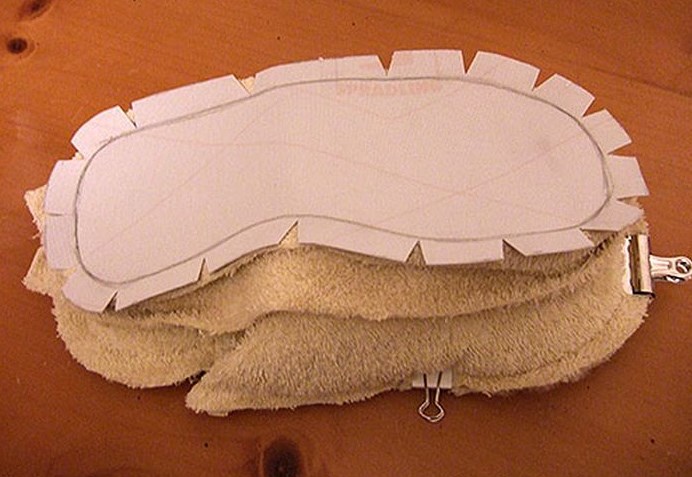
The stages of their creation will be as follows:
| Stage | Description |
| Make patterns | To do this, place your foot on the material and trace around it, or take old slippers and apply them to the fabric. This will determine the correct size. In total, 6 elements must be cut out:
It is best to make both the upper part and the lining from terry cloth. This way the shoes will be soft and cozy. In addition, the sewing process itself will be quite simple in this case. |
| Perform work on the inner layer | For the inner layer, you can use foam rubber or other insulating material. Another layer is placed under the heel, and then it needs to be secured with a stitch. Those who intend to use a sewing machine should remember that it does not go well on foam rubber. To facilitate tightening, a mesh should be placed on the material. Foam rubber is also placed in the upper part of the slippers. |
| Connect the top part with the lining | The sole can be taken from old slippers. It is better to make shoes a little larger than the size of the foot. Then they will be cozy, and it will be easier to put them on. |
| Assemble the elements into a single structure | You can use a sewing machine (a 120 needle is best). Be careful when sewing: reduce the speed when passing through the thickest sections. |
| Perform facing | From the terry cloth, you need to cut a strip 4 cm wide and the length equal to the diameter of the sole. This will create a facing for finishing the edge of the shoe. The facing should be sewn on from the sole side. |
From an old sheepskin coat
If you have an old sheepskin coat in your closet that no one has worn for a long time, instead of throwing it away, you can make comfortable slippers out of it. The front part of the shoe is best cut out of the sleeves. The part of the outerwear that has no seams is best suited for the sole.
When sewing such slippers, you must adhere to the following steps:
- Make a template on thick paper, and then transfer the drawing to the base material. This is done because the leather is thick and it will be difficult to fix the pattern on it.
- Cut out the parts using large and sharp scissors. If the craftsman decides to use small scissors, he will not succeed, because the tool will not cope with thick material.
- Place the cut out paper pattern on the fabric and attach it to it with needles. This will make it easier to trace the pattern. It is best to use chalk for tracing.
- To process the edges of the product, take an awl. It is better to use a sewing tool that has a special small hole for threading. As soon as the material is pierced and the tip comes out, thread the thread through the eye.
- Make another hole in the material with an awl. It should be next to the previous one. The tip of the awl is also brought out, and the thread that was brought out earlier is threaded through its eye. It is pulled to the other side of this leather part.
- Turn the part over and perform the same manipulations on the other side.
- Start sewing the top parts and lapels. To make a lapel, attach the boot shaft to the top of the slipper. The 2 halves are fastened with a seam inside. If the material of the sheepskin coat is not very thick, then a large needle is used. If the fabric is very dense, then it is better to work with a sewing awl.
- To make a durable sole, combine several layers of different materials at once. The upper part, called the insole, is made of cotton fabric or sheepskin. The middle layer is best made of synthetic padding or foam rubber. You can use thick paper or felt. Leather, rubber and raincoat fabric are good for the bottom of the sole. It can be difficult to combine all these layers. Here, strong threads and a sewing awl will come to the rescue.
- When the sole of the slippers is done, connect it to the upper part. The seam from the connection can be left outside, or hidden inside. In the first case, it is recommended to use threads of a contrasting color. This will make the shoes beautiful and bright. As an addition, you can use fittings.
- When all the details are sewn, turn the bootleg with the fur facing out.
From a blanket
The process of sewing slippers from a blanket goes through the following stages:
- Make a pattern for the bottom of one slipper. To do this, take a sheet of thick paper. Place the foot on it and trace it with a pencil or pen. In this example, the length is considered to be 24 cm. In addition, make indents for the seams - 5 mm along the entire diameter of the drawing. As a result, you will get a pattern 25 cm long.
- Make a pattern for the upper part. To do this, draw a rectangle on another sheet of paper, the length of which should be the same as the diameter of the drawing made in the previous step. The width of this rectangle should be equal to the widest part of the foot. In this example, the widest part of the foot is 10 cm.
- Continue working on the pattern of the upper part. From one end, put 10 cm down to form a square. Then, draw an arc line that should cover the toe. The height of the heel is 8 cm. Having measured it, you need to draw a parallel line, trying to round it near the square.
- Cut out the pattern you made. The main thing in this matter is accuracy and precise adherence to the drawings.
- Fold the fabric in half, place the pattern on it, take scissors and cut out the pieces.
- Once the pieces are cut out, sew the top together using a simple overlock stitch.
- Sweep both parts of the slippers, and then connect the parts again along the perimeter with the same seam.
- Pull out the basting stitch.
Fur slippers
House slippers (the life-size pattern can be made from various materials) made of fur will require the required amount of fur fabric to make. This simple but very warm footwear consists of 2 elements, so it usually takes about 2 hours or less to make. It all depends on the person's skill level.
The process consists of the following stages:
- Place your foot on thick paper and trace around your foot with a pencil or pen.
- Add 2-4 cm to the drawing that will be obtained as a result of tracing from both ends.
- Place a piece of paper on the top of your foot so that it extends from your toes to your instep.
- At the point of contact with the floor, trace the sheet of paper you just placed with a writing instrument.
- Add another 2-4 cm to the resulting pattern.
- Cut out the blanks and create copies of them so that each of the 2 slippers has its own patterns.
- Once the pattern is made, place the resulting drawings on the prepared fur fabric, trace them, and then carefully cut out the details. Considering that each part consists of an inner and an outer part, sewing a slipper will require 4 blanks - 2 for the sole and 2 for the top.
- Connect the elements obtained in the previous stages. First, the lower and upper parts are pinned together. Then, stitch the connection point and finish the edge.
If the slippers do not warm your feet very well, you can insulate them by making a batting insert in the sole. It is worth keeping in mind that it is better to cut this insert so that it is 2 mm smaller around the entire perimeter. In this case, it will be possible to hide it well, and the shoes themselves will turn out beautiful and neat.
It is recommended to make the outer part of the slippers from synthetics or genuine leather. This will increase the service life of the products.
A life-size pattern is a simple matter that even beginners can handle. And house slippers made on their basis look beautiful and warm feet in the cold season. Such shoes will appeal most of all to small children, who are sometimes difficult to get to walk around the house in indoor slippers.
Video about sewing house slippers
How to sew house slippers from jeans:
